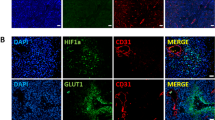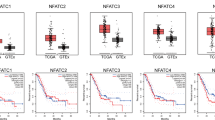Abstract
Purposes
To utilize non-invasive MRI imaging for real-time testing the synergistic effects of HSP90 inhibitor and glycolysis inhibitor for pancreatic cancer therapy in spontaneous pancreatic cancer mouse model.
Material and methods
Transgenic RIP1-Tag2 spontaneous pancreatic cancer mice were treated with geldanamycin (GA, 5 mg/kg) and /or 3-Bromo-pyruvate (3-BrPA, 5 mg/kg) from 8 to 12 weeks of age. Non-invasive MRI imaging measured and calculated the total tumor mass and volumes in real-time and compared to ex vivo tumors size. Serum VEGF levels were measured by ELISA. HSP 90 client protein levels (AKT and VEGF) were measured by western blots.
Results
RIP-Tag2 transgenic mice developed pancreatic tumors from 8 to 12 weeks of age. Non-invasive MRI imaging detected primary tumors in pancreas and metastasis in intestine and mesenterium with minimal resolution of 20 mm3. VEGF, AKT, hexokinase II, and Hsp90 were expressed in the pancreatic cancer tissues from RIP1-Tag2 transgenic mice. Combination of GA and 3-BrPA decreased serum VEGF levels by 70% compared to control group. Non-invasive MRI imaging showed that combination of GA and 3-BrPA inhibited pancreatic tumor and metastasis by more than 90% and significantly prolonged life span of RIP1-Tag2 transgenic pancreatic cancer mice. The synergistic effect of geldanamycin and 3-BrPA is through inhibition of two different pathways on HSP90 for its client protein degradation and on HK II for energy metabolism.
Conclusion
Non-invasive MRI imaging revealed synergistic effects of Hsp90 inhibitors and glycolysis inhibitors, which may provide a new therapeutic option for pancreatic cancer therapy.







Similar content being viewed by others
References
Parker SL, Davis KJ, Wingo PA, Ries LA, Heath CW Jr (1998) Cancer statistics by race and ethnicity. CA Cancer J Clin 48:31–48
Li D, Xie K, Wolff R, Abbruzzese JL (2004) Pancreatic cancer. Lancet 363:1049–1057
Spratlin J, Sangha R, Glubrecht D, Dabbagh L, Young JD, Dumontet C, Cass C, Lai R, Mackey JR (2004) The absence of human equilibrative nucleoside transporter 1 is associated with reduced survival in patients with gemcitabine-treated pancreas adenocarcinoma. Clin Cancer Res 10:6956–6961
Laheru D, Biedrzycki B, Jaffee EM (2001) Immunologic approaches to the management of pancreatic cancer. Cancer J 7:324–337
Pardoll D, Allison J (2004) Cancer immunotherapy: breaking the barriers to harvest the crop. Nat Med 10:887–892
Buchler P, Reber HA, Buchler M, Shrinkante S, Buchler MW, Friess H, Semenza GL, Hines OJ (2003) Hypoxia-inducible factor 1 regulates vascular endothelial growth factor expression in human pancreatic cancer. Pancreas 26:56–64
Ghaneh P, Kawesha A, Evans JD, Neoptolemos JP (2002) Molecular prognostic markers in pancreatic cancer. J Hepatobiliary Pancreat Surg 9:1–11
Warburg O (1956) On the origin of cancer cells. Science 123:309–314
Gatenby RA (1995) The potential role of transformation-induced metabolic changes in tumor-host interaction. Cancer Res 55:4151–4156
Dang CV, Semenza GL (1999) Oncogenic alterations of metabolism. Trends Biochem Sci 24:68–72
Seagroves TN, Ryan HE, Lu H, Wouters BG, Knapp M, Thibault P, Laderoute K, Johnson RS (2001) Transcription factor HIF-1 is a necessary mediator of the pasteur effect in mammalian cells. Mol Cell Biol 21:3436–3444
Chen C, Pore N, Behrooz A, Ismail-Beigi F, Maity A (2001) Regulation of glut1 mRNA by hypoxia-inducible factor-1. Interaction between H-ras and hypoxia. J Biol Chem 276:9519–9525
Harris AL (2002) Hypoxia—a key regulatory factor in tumour growth. Nat Rev Cancer 2:38–47
Weber G (1977) Enzymology of cancer cells (second of two parts). N Engl J Med 296:541–551
Weber G (1977) Enzymology of cancer cells (first of two parts). N Engl J Med 296:486–492
Younes M, Brown RW, Stephenson M, Gondo M, Cagle PT (1997) Overexpression of Glut1 and Glut3 in stage I nonsmall cell lung carcinoma is associated with poor survival. Cancer 80:1046–1051
Younes M, Brown RW, Mody DR, Fernandez L, Laucirica R (1995) GLUT1 expression in human breast carcinoma: correlation with known prognostic markers. Anticancer Res 15:2895–2898
Gambhir SS (2002) Molecular imaging of cancer with positron emission tomography. Nat Rev Cancer 2:683–693
Haberkorn U, Morr I, Oberdorfer F, Bellemann ME, Blatter J, Altmann A, Kahn B, van Kaick G (1994) Fluorodeoxyglucose uptake in vitro: aspects of method and effects of treatment with gemcitabine. J Nucl Med 35:1842–1850
Haberkorn U, Ziegler SI, Oberdorfer F, Trojan H, Haag D, Peschke P, Berger MR, Altmann A, van Kaick G (1994) FDG uptake, tumor proliferation and expression of glycolysis associated genes in animal tumor models. Nucl Med Biol 21:827–834
Burt BM, Humm JL, Kooby DA, Squire OD, Mastorides S, Larson SM, Fong Y (2001) Using positron emission tomography with [(18)F]FDG to predict tumor behavior in experimental colorectal cancer. Neoplasia 3:189–195
Waki A, Fujibayashi Y, Magata Y, Yokoyama A, Sadato N, Tsuchida T, Ishii Y, Yonekura Y (1998) Glucose transporter protein-independent tumor cell accumulation of fluorine-18-AFDG, a lipophilic fluorine-18-FDG analog. J Nucl Med 39:245–250
Younes M, Lechago LV, Somoano JR, Mosharaf M, Lechago J (1996) Wide expression of the human erythrocyte glucose transporter Glut1 in human cancers. Cancer Res 56:1164–1167
Hanahan D (1985) Heritable formation of pancreatic beta-cell tumours in transgenic mice expressing recombinant insulin/simian virus 40 oncogenes. Nature 315:115–122
Folkman J, Watson K, Ingber D, Hanahan D (1989) Induction of angiogenesis during the transition from hyperplasia to neoplasia. Nature 339:58–61
Bergers G, Javaherian K, Lo KM, Folkman J, Hanahan D (1999) Effects of angiogenesis inhibitors on multistage carcinogenesis in mice. Science 284:808–812
Schaffhauser B, Veikkola T, Strittmatter K, Antoniadis H, Alitalo K, Christofori G (2006) Moderate antiangiogenic activity by local, transgenic expression of endostatin in Rip1Tag2 transgenic mice. J Leukoc Biol 80:669–676
Alfke H, Kohle S, Maurer E, Celik I, Rascher-Friesenhausen R, Behrens S, Heverhagen JT, Peitgen HO, Klose KJ (2004) Analysis of mice tumor models using dynamic MRI data and a dedicated software platform*. Rofo 176:1226–1231
Hellwig D, Menges M, Schneider G, Moellers MO, Romeike BF, Menger MD, Kirsch CM, Samnick S (2005) Radioiodinated phenylalanine derivatives to image pancreatic cancer: a comparative study with [18F]fluoro-2-deoxy-D-glucose in human pancreatic carcinoma xenografts and in inflammation models. Nucl Med Biol 32:137–145
Medarova Z, Pham W, Kim Y, Dai G, Moore A (2006) In vivo imaging of tumor response to therapy using a dual-modality imaging strategy. Int J Cancer 118:2796–2802
Bouvet M, Spernyak J, Katz MH, Mazurchuk RV, Takimoto S, Bernacki R, Rustum YM, Moossa AR, Hoffman RM (2005) High correlation of whole-body red fluorescent protein imaging and magnetic resonance imaging on an orthotopic model of pancreatic cancer. Cancer Res 65:9829–9833
Wild D, Behe M, Wicki A, Storch D, Waser B, Gotthardt M, Keil B, Christofori G, Reubi JC, Macke HR (2006) [Lys40(Ahx-DTPA-111In)NH2]exendin-4, a very promising ligand for glucagon-like peptide-1 (GLP-1) receptor targeting. J Nucl Med 47:2025–2033
Speiser DE, Miranda R, Zakarian A, Bachmann MF, McKall-Faienza K, Odermatt B, Hanahan D, Zinkernagel RM, Ohashi PS (1997) Self antigens expressed by solid tumors Do not efficiently stimulate naive or activated T cells: implications for immunotherapy. J Exp Med 186:645–653
De Lott LB, Morrison C, Suster S, Cohn DE, Frankel WL (2005) CDX2 is a useful marker of intestinal-type differentiation: a tissue microarray-based study of 629 tumors from various sites. Arch Pathol Lab Med 129:1100–1105
Nozawa H, Chiu C, Hanahan D (2006) Infiltrating neutrophils mediate the initial angiogenic switch in a mouse model of multistage carcinogenesis. Proc Natl Acad Sci U S A 103:12493–12498
Inoue M, Hager JH, Ferrara N, Gerber HP, Hanahan D (2002) VEGF-A has a critical, nonredundant role in angiogenic switching and pancreatic beta cell carcinogenesis. Cancer Cell 1:193–202
Berlin JD, Catalano P, Thomas JP, Kugler JW, Haller DG, Benson AB 3rd (2002) Phase III study of gemcitabine in combination with fluorouracil versus gemcitabine alone in patients with advanced pancreatic carcinoma: Eastern Cooperative Oncology Group Trial E2297. J Clin Oncol 20:3270–3275
Colucci G, Giuliani F, Gebbia V, Biglietto M, Rabitti P, Uomo G, Cigolari S, Testa A, Maiello E, Lopez M (2002) Gemcitabine alone or with cisplatin for the treatment of patients with locally advanced and/or metastatic pancreatic carcinoma: a prospective, randomized phase III study of the Gruppo Oncologia dell’Italia Meridionale. Cancer 94:902–910
Kindler HL, Friberg G, Singh DA, Locker G, Nattam S, Kozloff M, Taber DA, Karrison T, Dachman A, Stadler WM, Vokes EE (2005) Phase II trial of bevacizumab plus gemcitabine in patients with advanced pancreatic cancer. J Clin Oncol 23:8033–8040
Shibaji T, Nagao M, Ikeda N, Kanehiro H, Hisanaga M, Ko S, Fukumoto A, Nakajima Y (2003) Prognostic significance of HIF-1 alpha overexpression in human pancreatic cancer. Anticancer Res 23:4721–4727
Ogata M, Naito Z, Tanaka S, Moriyama Y, Asano G (2000) Overexpression and localization of heat shock proteins mRNA in pancreatic carcinoma. J Nippon Med Sch 67:177–185
Baker CH, Solorzano CC, Fidler IJ (2002) Blockade of vascular endothelial growth factor receptor and epidermal growth factor receptor signaling for therapy of metastatic human pancreatic cancer. Cancer Res 62:1996–2003
Bruns CJ, Solorzano CC, Harbison MT, Ozawa S, Tsan R, Fan D, Abbruzzese J, Traxler P, Buchdunger E, Radinsky R, Fidler IJ (2000) Blockade of the epidermal growth factor receptor signaling by a novel tyrosine kinase inhibitor leads to apoptosis of endothelial cells and therapy of human pancreatic carcinoma. Cancer Res 60:2926–2935
Yamanaka Y, Friess H, Kobrin MS, Buchler M, Beger HG, Korc M (1993) Coexpression of epidermal growth factor receptor and ligands in human pancreatic cancer is associated with enhanced tumor aggressiveness. Anticancer Res 13:565–569
Sanderson S, Valenti M, Gowan S, Patterson L, Ahmad Z, Workman P, Eccles SA (2006) Benzoquinone ansamycin heat shock protein 90 inhibitors modulate multiple functions required for tumor angiogenesis. Mol Cancer Ther 5:522–532
Sebastian S, Kenkare UW (1998) Expression of two type II-like tumor hexokinase RNA transcripts in cancer cell lines. Tumor Biol 19:253–260
Rasschaert J, Malaisse WJ (1995) Activity of cytosolic and mitochondrial enzymes participating in nutrient catabolism of normal and tumoral islet cells. Int J Biochem Cell Biol 27:195–200
Therasse P, Arbuck SG, Eisenhauer EA, Wanders J, Kaplan RS, Rubinstein L, Verweij J, Van Glabbeke M, van Oosterom AT, Christian MC, Gwyther SG (2000) New guidelines to evaluate the response to treatment in solid tumors. European Organization for Research and Treatment of Cancer, National Cancer Institute of the United States, National Cancer Institute of Canada. J Natl Cancer Inst 92:205–216
Author information
Authors and Affiliations
Corresponding author
Additional information
Xianhua Cao and Guang Jia have contributed equally to this work.
Rights and permissions
About this article
Cite this article
Cao, X., Jia, G., Zhang, T. et al. Non-invasive MRI tumor imaging and synergistic anticancer effect of HSP90 inhibitor and glycolysis inhibitor in RIP1-Tag2 transgenic pancreatic tumor model. Cancer Chemother Pharmacol 62, 985–994 (2008). https://doi.org/10.1007/s00280-008-0688-8
Received:
Accepted:
Published:
Issue Date:
DOI: https://doi.org/10.1007/s00280-008-0688-8




